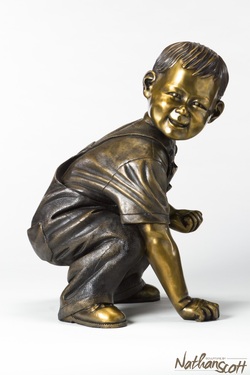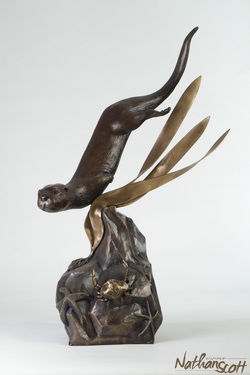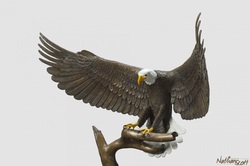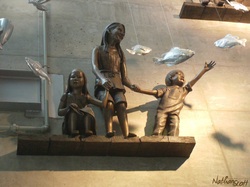 I’m writing this as I’ve just wrapped up the first of two studio tours I do each year. I’ve been opening my studio up for studio tours for years. Like everything else in the art world, some tours have been profitable and others have been dismal. The beauty of it all is that the cost of putting on the show is minimal except all the time it takes and the rewards can be well worth your time...you never really know the outcome of a show at the time. Some seeds can be dormant for years-but one thing is certain: when a person falls in love with a piece of art, they don’t soon forget it. I’ve had people come back years later to finally make their purchase. Collaboration: I’ve done studio tours primarily with some success, but I’ve always done better when it is a collaboration with as much larger tour. I happen to live on a peninsula on a small island in the Pacific. The Community Arts Council of the Saanich Peninsula, or CACSP, facilitates this self-guided tour. There are approximately 26 studios that participate in the area. For a reasonable fee, the CACSP takes care of putting together brochures, signs, and marketing the event. The rest is up to us. What you do from there really can make a difference to the success of the show. The “extras” that you offer on a studio tour can make all the difference. Offering Demonstrations: I always like to offer demonstrations. People are always interested in the creative process, whether they themselves are creative or not. This latest tour that I just finished had demonstrations of clay being sculpted, a painting being painted, and even a rock carver chipping away. People are always interested in seeing the different tools and how they are used. They enjoy following the progress of a piece of art. A big bonus for my studio is that I have my own foundry on site and people enjoy walking through the whole process, seeing different pieces at each stage. It’s all about holding a person’s interest for longer, and helping them appreciate the amount of work and steps that go into creating a bronze sculpture or other piece of art that can often generate sales. When they see the process, people understand the value of a hand-crafted, quality piece of artwork, and people will pay for what they appreciate and love. A Variety of Different Artists: You might have noticed that I’m not alone when I put on a studio tour. It’s not that I have a low self- esteem and can’t put on a show by myself! There are several reasons to show with a variety of different artists. I try to have a mixture of some of the same and some new artists at each studio tour I do. I think it makes for a more pleasant experience for the client if there is more to appeal to their senses. I’ve also come to the realization that it’s not all about me and not everybody likes my style of art! I also like promoting other artists. This last show, I asked a guy to join us who had never shown his work publically. I told him to put prices on all his pieces. He was a bit reluctant, but before the show was over, WHAMO! His first art sale: $5400.00! Not bad for a first time out! “Way to go, Oly!” I’ll usually have other sculptors join my studio tour, but I always include painters as well because they brighten up the room, draw people in and bring out colour in different sculptures as well. Plus, with other artists on site, it sure makes preparing, cleaning, and tearing the show down a lot easier. That may be the main reason I include them!! Perhaps the biggest bonus of collaborating is that each artist benefits from the other’s client base. Some artists are really funny about this and I believe it’s short sighted on their behalf. They try to keep their client base exclusively to themselves, thinking they can somehow control their client’s spending taste and habits. I remember once inviting a client to a show; he came, looked around, and then promptly went over to the booth across the aisle and bought a $2000 painting from the guy across from me. I was quite devastated at this, but did my best to put on a congratulating face at the painter had been having a much worse time of it than I was. It was his first sale of the whole show. But you know, the next day, that same client showed up with his sister and bought a sculpture for himself and for her! What was I worried about? Generally, if people buy art, they will buy several pieces from the same artist because they like that artist’s style. People who appreciate art also tend not to collect art from one artist exclusively. If you’re afraid your client will see someone else’s art and buy it instead of yours, you’re not very confident in your own art. That’s a far bigger block in the sale of your art than the fact that your client might enjoy another artist’s work. Show your work with confidence! If having your art around others intimidates you because you believe your work is inferior-take the opportunity to learn and improve. An Interesting Lesson: Here’s a bit of a bunny trail: it was at the Sculpture Invitational in Loveland, Colorado a few years back. Some clients were looking at sculptures of elk. They hummed and hawed, asking questions and talking about pricing with the artist. They then went off to see another artist that also specialized in elk at the same show. The clients then came back again to the first elk and engaged in some more conversation with the artist. They then moved off a bit to distance themselves from the artist and discuss more amongst themselves. This turned out to be too much for the artist and he lost it! He marched over to them with his 5 point sermon and explained that his sculptures were way better, the price was lower and the terms of installation and delivery were better and demanded to know why they were going to buy from this other guy, who, to bring up another point, was Canadian, while he himself was homegrown! After his rant settled down, the potential clients calmly told him that the decision they were now discussing was not whom to buy from, because they had already decided to buy from him-they were only discussing how many to buy! He got the sale… but he sure felt foolish! To bring it back to studio tours: they are not expensive to put on, they can be fun to do with others when there’s a lull in the crowd (a bit of wine doesn’t hurt here) and the people or perspective clients love to see the creative process and meet the artists themselves. All in all, I have found them to be very worth my while. I meet the most interesting people!
0 Comments
 The spring has sprung and for me as a sculptor, that means the beginning of art, garden, and sculpture shows. “If you have to sell the art, it can’t be that good! Art, if it’s good, will sell itself.” Yes, I believe there is some truth to that. I have had clients come and see a sculpture of mine and fall in love with it and buy it. Fifteen years later, I’ll see them around town and they can’t stop talking about how much they enjoy it daily. That’s a great feeling! But the more I do shows, the more I see that people sometimes need a good prompting to encourage them to spend money on art. I’m getting braver about this, too, because I realize I don’t have much to lose. As I talk to people, I’ve discovered that far more people suffer from ‘not buying regret’ rather than ‘buyer’s regret.’ I’ve had people almost in tears pleading with me to squeeze one more out of an edition after they have found out that it has sold out and the sculpture is no longer available. I, too, suffer from this same scenario. It was while I was on my honeymoon with my young bride on one of the Gulf Islands. On one of our day trips, we visited a local gallery in Ganges. I fell completely in love with this stone sculpture of two stylized tumbling ravens. It was great-it had so many under cuts and cut throughs and perspectively it was perfect from every side. I was overwhelmed with the artist’s technical ability and the captured sense of motion and beauty. The only thing that kept me back was the price. At that time of my young career as an artist, $5800 was a lot of money! I didn’t think it was quite the right moment to put that hefty expenditure on my bride! Now, looking back, I sure wish I had. I should have asked about a lay away plan or scraped up every dollar I could have found. I still to this day think back on that piece and know if I had bought it, I would not have regretted it an ounce. Sure there would have been sacrifice, but it was well worth it. So I sit here with regret. Note from ‘the young bride’: As I sit here typing this up for my husband, trying to make sense of his scrawled words and correct his grammar, I have to add my two bits to clarify! It was the dream honeymoon on a ‘small island in the Pacific.’ Well that small island was SALTSPRING which happens to be just a ferry ride away! It was all we could afford! I didn’t resent getting engaged before he could afford a ring, sewing my own wedding dress for a total of $100, going for the American-style luncheon instead of formal dinner, or even the week on Saltspring instead of some exotic location because true love is worth all that and more. There are sacrifices involved with marrying an artist who has a grand total of three sculptures in his collection! $5800 was pretty well his entire year’s income back then! Buyer’s regret or no, had he shelled it out, there would have been more than ‘buyer’s regret!’ If, however, he had been able to work out a deal where he could have traded sculpture, we would have both been happy. My advice: a little balance is a good thing! Yes, art is important-it brings beauty and pleasure to us every day, and if you find a piece you love and buying it doesn’t mean deciding between the piece of art or eating and paying your mortgage, by all means, go ahead. If you can cut in another area of pleasure to afford it, I say, ‘what’s taking you so long?’ If you really can’t afford it but you love it, my advice is to talk to the artist. What is your business? What can you offer? Find out if the artist is willing to trade. Artists love art. They also don’t tend to have a lot of cash for extra perks. Be creative. If a house painter offered to paint my house on the weekends in trade, or a dentist offered dental work, or someone had nice furniture they were about to upgrade, or a person had air miles and a week’s timeshare-I’d sure consider these! All I’m saying is ‘be creative.’ Artists are creative by nature! Just don’t be offensive. We work so hard and sacrifice so much in order to produce art. Nathan has traded art for a week’s vacation with our family complete with tours in the client’s private airplane, several paintings and other sculptures, a new septic field, and most recently, a hand-made electric guitar that he tells me is a work of art in itself even if he can’t play a lick! A fair trade makes everyone happy. Back to Nathan: Now back to my shows. I see several people a year who see a piece of mine and are moved by it but walk away because of the price-or they think they’ll wait until next year. I’ve started to wise up and realize that it’s not that people can’t afford it-they just have never spent this kind of money on art before. They’d easily spend the same money on a vacation or on a home renovation, but they aren’t used to giving themselves the same pleasure through art. I must point out however, that long after your vacation memories fade and your home renovation becomes obsolete, a good quality bronze sculpture continues to bring pleasure to you every time you look at it. After all, it does come with a 10,000 year warranty! It becomes an heirloom in your family for generations. It also helps people to realize why a sculpture is so expensive. Buying a hand-crafted bronze sculpture is an extensive process and the material costs are a large part of it. I can’t tell you how many people have taken a tour through my foundry and seen the process we go through to create a sculpture, that come out saying, “I had no idea there was so much involved to creating a sculpture!” So when a perspective client is waffling, such as the two I had at a show last year, I ask them if they would regret it later if they walked away. They both agreed that they would and took the risky step of buying a quality piece of art for the first time in their lives. Each walked away exceedingly pleased with their purchase. They will enjoy it every time they see it. If you love a piece of art, you will never regret the pleasure that it brings you. In my experience, the more I wrestled with it and sacrificed to have it because I just loved it, the more I enjoy it.  A question I get asked quite often is “How much would it cost to have my child/ grandchild cast in bronze?” In other words, they are asking how much a private commission of their child would cost-and this is great, because this is what I do! It’s a large part of my sculpting business and I love to create something that is special and unique to that person or family. The problem is, they usually ask this question just after looking at my limited edition line of children. ( a limited edition means that I sculpt one sculpture, make a mold of it and sell a limited amount of the same sculpture-usually 10 if it’s in bronze or 25 if it’s in cold cast bronze) The prospective client has seen the price of a limited edition sculpture and they think it would cost about the same to have their own child or grandchild made into a sculpture. People are often shocked at the price difference between a limited edition and commission work. I quite often feel a bit awkward as now I have to justify the price difference. When it comes to pricing a private commission, all of the costs of sculpting, mold making, casting, and installation have to be absorbed into the one sculpture instead of being spread out among all the pieces in an edition. With a limited edition sculpture, if a mold costs one thousand dollars to make and I will be making ten sculptures in the edition, the price is divided over those ten pieces, so these cost of the mold making are now only $100 per casting. The sculpting fees are also deferred. Sometimes people ask me if I would use their child as the model and make it into a limited edition. It depends on if I think the idea is marketable as a limited edition. Sometimes it’s a great sculpture, but the child is specifically designed for a particular rock it is to be sitting on or some other feature of its placement. Sometimes there is just a very limited clientele that would be interested in purchasing a sculpture of a potential client’s specific idea. The large Yorkshire pig I sculpted last year has a pretty limited clientele! Not all pig farmers want a life-size bronze pig in their front yard-though I think they should! I also recall a four headed cobra that I cast for a guy-where did that go and what are they using it for? When I come up with an idea for a limited edition sculpture, I usually sculpt it on spec. I think of an idea for a sculpture and how marketable I think it would be- if I don’t think enough people will open their wallets to pay for it, I can’t afford to sculpt it. I always keep in the back of my mind that I have a large family to support, mortgage and employees to pay! When I am hired by a client to sculpt their private commission, I become their employee for the duration of the time I am working on their sculpture. Of course there are many perks to getting your own design in a sculpture-but the client assume the responsibility of paying for all of my costs. On the other hand, with a limited edition, many people will ultimately share the cost of being my provider! I should note that there has been a time or two that somebody has approached me with a private commission and I have split them a great deal on the basis that I can make more than one because I see the possibility of selling more than one. For example, a client approached me with an idea of a landing eagle. I thought that was a great idea, so instead of charging him for the whole cost of one, I made him a deal which was quite a bit less. It paid for my sculpting and mold making. I’ll sell about five or more eagles. Another reason for wanting to do an edition of this eagle is that if I was about to go to all the work of sculpting all those wretched feathers, I might as well make a good buck at it!  A large portion of my sculpting is made up of private commissions and for that matter, public commissions as well. I enjoy doing them as each is very different and I like the challenge of capturing the subject’s character and bringing the client’s idea to reality. It all starts when I am approached by a client with an idea about a commission… and then the fun begins! WHAT The client usually takes a look at the sculptures I have already created and comes to me with a definite idea of the subject they would like sculpted: “I would like to have a statue of my grandchild/ child/ cat/ dog.” WHERE Now that we know the ‘what,’ we figure out the ‘where.’ I usually ask where they want it located and if they will be able to see it from a variety of locations. The specific location may change the way it is sculpted. The sculpture could be standing or sitting on a bench, a specific rock, a wall, or I can provide a pedestal for it. I’ve even sculpted one boy climbing up a flagpole with his shoes and socks in bronze at the bottom of the pole! Details matter! Where I live, we have a variety of seasons so we’re not always outside. If the piece is to be outdoors, it is often best if it can be viewed equally well from the indoors so it brings enjoyment every day. HOW & OTHER DETAILS Another question to think about is ‘How will the subject be interacting with its surroundings? Will it be interacting with an animal, a (usually another) child or looking at something such as a pool or garden?’ The details of what the sculpture is doing will bring out its character. A few years back, I sculpted a clients two grandsons as toddlers. Their personalities were very different from each other. One was very sporty so he was sculpted playing with his favourite soccer ball and the other was very much into construction sites and dump trucks so I sculpted him riding on a big Tonka dump truck. THE PROCESS BEGINS Quite often the subject I’m going to sculpt has grown up. The client often wants them sculpted when they were children. I guess they were cuter then! In these circumstances, we agree on a pose, the clothing and I go and find a model with the same body type and size. I’ll take photos of the model in a couple of different poses and let the client decide which pose they like. I then get as many photos of their child at the age they are to be sculpted and super impose that head to the body of the model. Other times, especially with grandchildren, I’ll take photos of the individual or have a parent do that. Then I’ll work right from these photos. I don’t do too much sculpting from a posing live model because nobody wants to sit around for hours trying to hold a facial expression! Sometimes after I’ve done the bulk of the work, I’ll have the subject come in for a bit to do some final touches. Usually it’s the parent or grandparent that comes in and tells me to tweek a little here and there until we’re done. Once the client is perfectly happy and has “signed off” or accepted the clay sculpture, this is the point where the transformation from clay to bronze begins. MAKING THE MOLD The mold making is next in the process. This is the step of making a complete negative of the completed clay sculpture. This usually takes about one week to complete. CASTING After the mold is prepared, the casting process takes place. It’s a rather involved process that I’ll cover in another blog post, but you can see the basics on my website in a photo version. It’s quite labour intensive and frankly, a royal pain in the ***! DELIVERY AND INSTALLATION The best part for me and the client is the delivery and installation of the sculpture. This often happens several months after the process first began when everything has finally come together. My greatest compliment is when I exceed my client’s expectations. |
Nathan ScottInternational Bronze Sculptor Archives
October 2022
Categories
All
|

 RSS Feed
RSS Feed